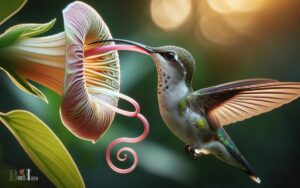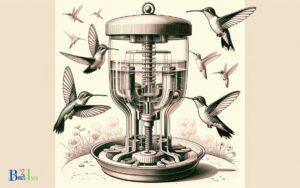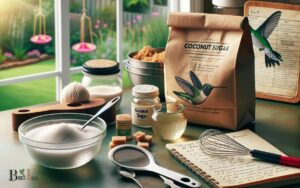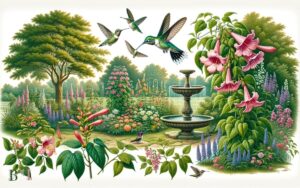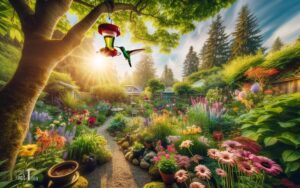Do Hummingbirds Prefer Homemade Nectar? Yes!
Yes, hummingbirds do often prefer homemade nectar as it closely resembles the natural nectar found in flowers.
Making nectar at home is a simple and cost-effective way to attract hummingbirds to your garden.
The ideal homemade nectar solution is a mixture of four parts water to one part white sugar, boiled to sterilize and then cooled before serving.
Hummingbirds are attracted to nectar that mimics the natural properties of flower nectar. Homemade nectar is preferable because it lacks additives and dyes that are sometimes present in store-bought options.
Hummingbirds require high-energy sustenance to maintain their rapid wing flapping, and a plain sugar solution provides this energy without unnecessary chemicals.
It’s important to note that homemade nectar should not contain any colorants, honey, or artificial sweeteners as these can be harmful to hummingbirds.
- Ingredients: 1 part white sugar to 4 parts water
- Preparation: Boil and cool
- Safety: No honey, artificial sweeteners, or dye
Homemade nectar is a sweet and simple way to delight your backyard hummingbirds without any harmful additives.
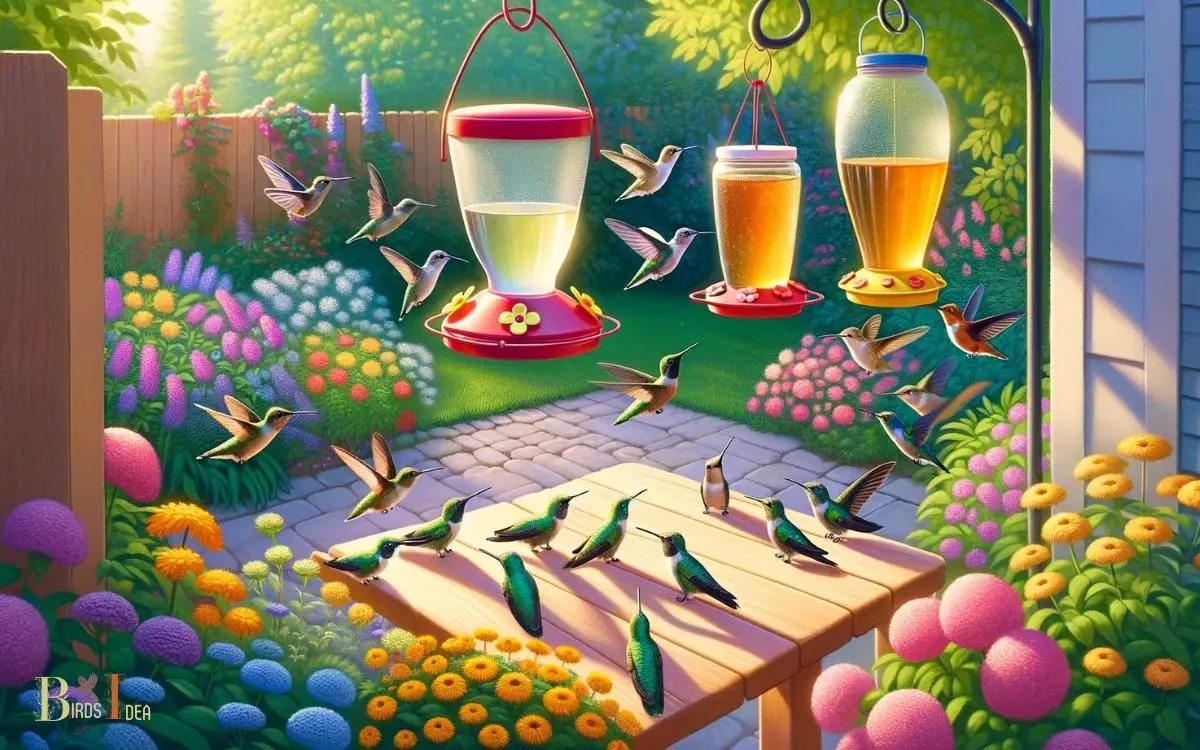
Key Takeaway
The Benefits of Homemade Nectar
The advantages of homemade nectar include freshness, purity, and nutritional quality. When serving hummingbirds, it is essential to prioritize their well-being, and homemade nectar ensures just that.
By preparing nectar at home, one can guarantee that it is free from any preservatives or additives that might be present in store-bought alternatives.
This purity is crucial for the health of the hummingbirds, as it reduces the risk of any harmful substances entering their delicate systems.
Homemade nectar can be prepared in small, fresh batches, ensuring that it is at its nutritional peak when offered to the hummingbirds.
This guarantees that the birds receive the highest quality of nutrients, which is essential, particularly during migration or breeding seasons.
Therefore, choosing homemade nectar demonstrates a commitment to serving the best interests of these remarkable creatures.
Understanding Hummingbird Preferences
Hummingbirds’ nectar preferences can provide valuable insights into their dietary needs and behaviors.
Understanding what attracts these tiny birds to certain types of nectar can help us provide the best possible care for them.
Research indicates that hummingbirds are naturally drawn to the color red, suggesting that they have a preference for red-flowered plants and feeders.
They show a preference for nectars with higher sugar concentrations, as these provide the energy necessary for their rapid metabolism.
By understanding these preferences, we can better cater to their needs by offering nectar solutions that align with their natural inclinations.
This knowledge allows us to create environments that are conducive to the well-being of these remarkable creatures, ensuring that we can serve them in the best possible way.
Factors Influencing Nectar Attraction
Factors influencing nectar attraction in hummingbirds include flower color, sugar concentration, and feeder design.
Hummingbirds are attracted to a wide range of flower colors, especially red, orange, and pink, as these colors signal a high nectar reward.
The sugar concentration in nectar is crucial, with a solution of four parts water to one part sugar closely resembling natural nectar and attracting these birds effectively.
Feeder design also plays a significant role in attracting hummingbirds, with features such as perches and bee guards enhancing their appeal.
Understanding these factors can help individuals create nectar sources that are highly attractive to hummingbirds, thereby contributing to the well-being and sustainability of these delightful creatures.
Comparing Homemade Vs. Store-Bought Nectar
When comparing homemade and store-bought nectar, it is essential to consider the quality and composition of the nectar to ensure the continued attraction of hummingbirds.
Factors to consider include:
- Freshness: Homemade nectar can be made fresh, without preservatives or additives commonly found in store-bought options.
- Cost: Homemade nectar is often more cost-effective, allowing for larger quantities to be made at a lower price.
- Customization: Homemade nectar allows for the adjustment of sweetness levels to match the preferences of local hummingbirds.
- Environmental Impact: Making nectar at home reduces the need for single-use plastic containers and transportation associated with store-bought nectar.
- Quality Control: By making nectar at home, one can ensure the use of high-quality ingredients and proper hygiene practices, promoting the health of visiting hummingbirds.
Tips for Making Homemade Nectar
To ensure the continued attraction of hummingbirds, it is important to consider several key tips for making homemade nectar.
- First, use a simple recipe of four parts water to one part white granulated sugar. Boil the water to remove impurities and then stir in the sugar until it dissolves. Let the mixture cool before filling the feeders.
- Secondly, avoid using honey, brown sugar, or artificial sweeteners, as these can be harmful to the hummingbirds.
- Thirdly, change the nectar every 2-3 days, especially in hot weather, to prevent fermentation and mold growth.
- Lastly, keep the feeders clean by washing them with hot water and using a bottle brush to remove any buildup.
By following these tips, hummingbirds can enjoy a safe and nutritious homemade nectar.
Ensuring Safe and Healthy Nectar
Ensuring the safe and healthy consumption of nectar by hummingbirds involves maintaining strict adherence to the recommended nectar recipe and cleanliness practices.
To ensure the well-being of these delicate creatures, consider the following:
- Use only white, granulated sugar to prepare the nectar.
- Boil the water to remove impurities and then mix it with the sugar at a ratio of 4 parts water to 1 part sugar.
- Avoid using honey, brown sugar, or artificial sweeteners, as they can be harmful to hummingbirds.
- Clean the feeders thoroughly every time you refill them to prevent the growth of mold and bacteria.
- Place the feeders in shaded areas to prevent the nectar from spoiling too quickly.
Is Homemade Nectar Better for Hummingbirds than Store-Bought Nectar?
When it comes to hummingbird nectar color comparison, many argue that homemade nectar is better than store-bought options. Homemade nectar allows you to control the ingredients and avoid additives, ensuring a healthier option for these delicate birds. However, it is essential to maintain the correct ratio of sugar to water for their well-being. Ultimately, providing safe and nutrient-rich nectar is crucial, regardless of its source.
Observing Hummingbird Behavior
When it comes to observing hummingbird behavior, understanding their nectar preferences is crucial.
By closely monitoring their interactions with both store-bought and homemade nectar, we can gain valuable insights into their preferences and behaviors.
This observation will provide a deeper understanding of the impact of homemade nectar on their foraging patterns and overall well-being.
Impact of Homemade Nectar
Our observations of hummingbird behavior provide valuable insights into the impact of homemade nectar on their feeding patterns and preferences.
Through careful monitoring, we have noticed distinct changes in their behavior when presented with homemade nectar compared to store-bought alternatives. This suggests that the quality of nectar plays a significant role in their feeding habits.
To illustrate this point, we have compiled a table detailing the observed behaviors of hummingbirds when offered different types of nectar:
| Nectar Type | Feeding Frequency | Aggression Level | Overall Behavior |
|---|---|---|---|
| Homemade Nectar | High | Low | More relaxed |
| Store-Bought Nectar | Low | High | Agitated |
| Natural Nectar | Moderate | Moderate | Normal |
These observations emphasize the importance of providing high-quality, homemade nectar to support the well-being of these magnificent creatures.
Conclusion
The preference of hummingbirds for homemade nectar over store-bought options signifies the importance of natural and authentic sources of nourishment.
By understanding the factors that influence their attraction to nectar, we can appreciate the significance of providing a safe and healthy environment for these delicate creatures.
Homemade nectar not only benefits the hummingbirds but also symbolizes our commitment to preserving the beauty and balance of the natural world.

